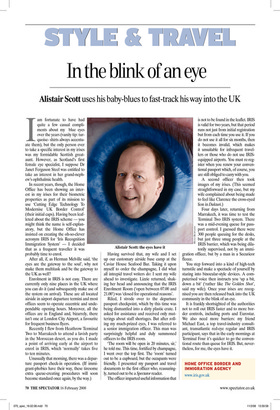STYLE & TRAVEL
In the blink of an eye
Alistair Scott uses his baby-blues to fast-track his way into the UK Iam fortunate to have had quite a few casual compliments about my blue eyes over the years (vanity tip: turquoiseshirts always accentuate them), but the only person ever to take a specific interest in my irises was my formidable Scottish greataunt. However, as Scotland’s first female eye specialist, I suppose Dr Janet Ferguson Steel was entitled to take an interest in her grand-nephew’s ophthalmic health.
In recent years, though, the Home Office has been showing an interest in my irises for their biometric properties as part of its mission to use ‘Cutting Edge Technology To Modernise UK Border Control’ (their initial caps). Having been leafleted about the IRIS scheme — you might think the name is self-explanatory, but the Home Office has insisted on creating the oh-so-clever acronym IRIS for ‘Iris Recognition Immigration System’ — I decided that as a frequent traveller it was probably time to enrol.
After all, if, as Herman Melville said, ‘the eyes are the gateway to the soul’, why not make them multitask and be the gateway to the UK as well?
Enrolment in IRIS is not easy. There are currently only nine places in the UK where you can do it (and subsequently make use of the system on arrival). These are all located airside in airport departure termini and most offices seem to operate eccentric and undependable opening hours. Moreover, all the offices are in England and, bizarrely, there isn’t one at London City Airport, a favourite for frequent business flyers.
Recently I flew from Heathrow Terminal Two to Marrakech to attend a lavish party in the Moroccan desert, as you do. I made a point of arriving early at the airport to enrol in IRIS, which ‘normally’ takes five to ten minutes.
Unusually that morning, there was a departure passport check-in operation. (If immigrant-phobics have their way, these tiresome extra queue-creating procedures will soon become standard once again, by the way.) Having survived that, my wife and I set up our customary airside base camp at the Caviar House Seafood Bar. Taking it upon myself to order the champagne, I did what all intrepid travel writers do: I sent my wife ahead to investigate. Lizzie returned, shaking her head and announcing that the IRIS Enrolment Room (‘open between 07.00 and 21.00’) was ‘closed for operational reasons’.
Riled, I strode over to the departure passport checkpoint, which by this time was being dismantled into a dirty plastic crate. I asked for assistance and received only mutterings about staff shortages. But after rolling my much-prized eyes, I was referred to a senior immigration officer. This man was surprisingly helpful and duly summoned officers to the IRIS room.
‘The room will be open in 20 minutes, sir,’ he told me. This time, fortified by champagne, I went over the top first. The ‘room’ turned out to be a cupboard, but the occupants were friendly. I presented my passport and travel documents to the first officer who, reassuringly, turned out to be a Spectator reader.
The officer imparted useful information that is not to be found in the leaflet. IRIS is valid for two years, but that period runs not just from initial registration but from each time you use it. If you do not use it all for six months, then it becomes invalid, which makes it unsuitable for infrequent travellers or those who do not use IRISequipped airports. You must re-register when you renew your conventional passport which, of course, you are still obliged to carry with you.
A second officer then took images of my irises. (This seemed straightforward in my case, but my wife complained about being made to feel like Clarence the cross-eyed lion in Daktari.) Four days later, returning from Marrakech, it was time to test the Terminal Two IRIS system. There was a mid-evening queue for passport control. I guessed there were 300 people queuing for the desks, but just three smug people at the IRIS barrier, which was being dilatorily supervised, not by an immigration officer, but by a man in a Securicor fleece.
You step forward into a kind of high-tech turnstile and make a spectacle of yourself by staring into binocular-style devices. A computerised voice then instructs you ‘up a bit, down a bit’ (‘rather like The Golden Shot’, said my wife). Once your irises are recognised you are then released back into the UK community in the blink of an eye.
It is frankly shortsighted of the authorities not to roll out IRIS faster and to more border controls, including ports and Eurostar. We also need more barriers: my friend Michael East, a top travel-industry consultant, transatlantic red-eye regular and IRIS participant, says that in the early mornings at Terminal Four it’s quicker to go the conventional route than queue for IRIS. But, nevertheless, for me, the eyes have it. HuGo BuRNAND


















































































 Previous page
Previous page